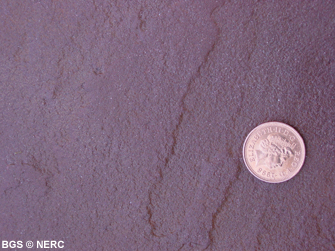
The rocks of Mendip
Silurian | Devonian | Lower Carboniferous | Upper Carboniferous | Triassic | Lower to Middle Jurassic
Upper Devonian rocks (385 to 359 million years ago)
Devonian rocks form the highest ground on the Mendips, rising to around 300 m in the cores of the anticlinal folds of Blackdown, North Hill, Pen Hill and Beacon Hill. Where the base of the succession is unproved at Blackdown, in the western Mendips, there are at least 500 m of Devonian strata, reducing to 400 m on Beacon Hill where Devonian rocks unconformably overlie Silurian volcanics. The Devonian of the Mendips is represented by the Portishead Formation, informally known as the Old Red Sandstone.
Portishead Formation (Old Red Sandstone)

These rocks were deposited by meandering river systems flowing across an arid continental environment at the southern margin of a large landmass. The rocks comprise dull red sandstone, interbedded with fine-grained mica-rich sandstone and sandy green, red and purplish shales and mudstones. Pebbly sandstones and conglomerates occur in the lower part of the succession, and thick beds of mudstone become more common towards the top. The Portishead Formation belongs to the upper Devonian; older Devonian rocks, represented in the nearby Clevedon area by the Black Nore Sandstone Formation and overlying Woodhill Bay Conglomerate are absent. A plant and fish-bearing conglomerate occurs near the top of the formation at Burrington, on the north side of Blackdown, and may equate with a similar bed in the Bristol district named the Sneyd Park Fish Bed. The fossilised remains of plant spores show that the Devonian / Carboniferous boundary in the Mendips is within the top of the Portishead Formation; the marine conditions that are usually typical of the Carboniferous affected the Mendips slightly later than elsewhere.
- Home
- Overview maps
- Locality
areas
- Cheddar Gorge
- Charterhouse
- Blackdown
- Burrington Combe
- Shipham & Rowberrow
- Crook Peak & Axbridge
- Banwell to Churchill
- Priddy
- Harptree & Smitham Hill
- Draycott & Westbury-sub-Mendip
- Wookey Hole & Ebbor Gorge
- Wells
- Great Elm & Vallis Vale
- Mells & the Wadbury Valley
- The Vobster area
- The Whatley area
- Torr Works & Asham Wood
- Beacon Hill
- Stoke St Michael & Oakhill
- Holwell & Nunney
- Shepton Mallet & Maesbury
- Gurney Slade & Emborough
- The Nettlebridge valley
- Geology
- Minerals and mines
- Quarrying
- Caves and karst
- Biodiversity
- Detailed site information
- Acknowledgements
- External links
- Search
- Site map